Development in prone can be quite variable, especially in infants who have a degree of developmental delay associated with preterm birth, and who are at a high risk for cerebral palsy and infant who are hypermobile or have a very cautious nature.
Although infants with atypical development may not tolerate being prone on a flat surface, there are other options for providing infants with opportunities to develop the neck and trunk flexibility and muscle strength promoted by spent time in prone, as well as the ability to take weight on the UEs in preparation crawling.
The TOMT 0-3 assessment includes items that allow the therapist to identify different ways in which the physical environment can be adapted to allow the infant to assume a prone lying position, develop trunk extension in prone and start to explore possibilities for taking weight on the UE.
Prone of a flat firm surface
Start by getting a general impression of the infant's abilities in prone. Let the infant lie in prone on a firm, but not hard, flat surface. Position the UEs with the hands next to or ahead of the infant's head.

Observe
► Is the infant comfortable in this position? Does the infant roll back into supine almost immediately?
► Does the infant lift the head? Is neck extension associated with extension of the thoracic and lumbar spine?
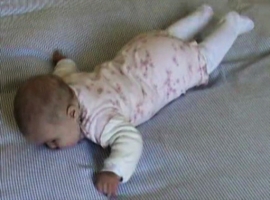
► Does the infant lift the head and shoulder girdle up off the support surface and take weight on the forearms?
► If the infant is positioned supporting on the forearms, does she maintain the position for a few seconds at least?

► Does the infant push up on the UEs, taking weight on the hands and extending the elbows, even briefly?
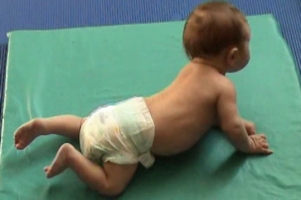
Posture and abilities lying on a caregiver's chest
Let the caregiver lie with the back supported at about a 20-45 degree angle. Let the infant lie prone on the caregiver's chest. Move the infant's hands to shoulder or head height.
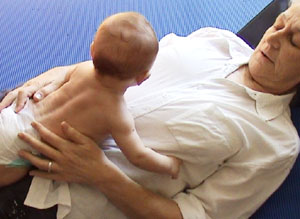
Observe
► Does the infant like/tolerate this position?
► Does she push down on her hands and lift her head and shoulders?
► Is head lifting associated with thoracic extension?
Posture and abilities when carried upright facing a caregiver's chest.
Infant's are often carried upright, either supported by the caregiver's hands or by a sling. The amount of support needed by the infant's decreases as the infant's trunk stability and postural control improve with age and experience.
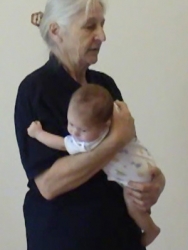
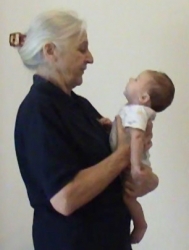
Observe
► The infant's trunk and head posture and level of activity. Note the position of the upper and lower extremities.
► The amount of support provided by the caregiver: full support around the chest, or light support around the chest.
► Does the infant lift the head to look at the caregiver? Does the infant turn the head to look around?
Posture and abilities lying over a rolled up blanket
Infants who do not like lying on a a flat surface, will sometimes tolerate prone when supported under the chest so that the head and shoulders are lifted up off the surface and it is easier to keep the head up and use the UEs for support.
I like to use a rolled up fleece blanket - it is soft and the roll can be bent to provide some lateral support.

Observe
► Ability to maintain neck and trunk extension with some weight on the forearms.
► Position of the head - in line with the trunk or with face at 450 angle.
► Ability to lift one hand and reach for a toy with extended elbows?